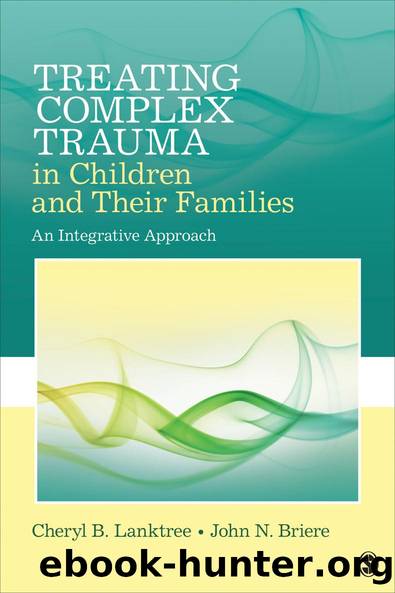Treating Complex Trauma in Children and Their Families by Cheryl B. Lanktree John N. Briere

Author:Cheryl B. Lanktree, John N. Briere [Cheryl B. Lanktree, John N. Briere]
Language: eng
Format: epub
Tags: Social Science, Human Services, Social Work
ISBN: 9781483389950
Google: P3xZDwAAQBAJ
Publisher: SAGE Publications
Published: 2016-01-04T04:38:13+00:00
An Exposure Philosophy
The reader will note that the exposure activities outlined in this chapter are characterized by a significant level of permissiveness on the part of the clinician. He or she rarely takes the child through preconceived exposure hierarchies, but spends considerable time ensuring that the client is not overwhelmed by the process. In fact, ITCT-C clinicians generally encourage the client to determine what and how much traumatic material should be addressed in any given session. For example, the therapist often provides a number of options for the child client, including books, toys, art materials, and so forth, while encouraging the child to explore trauma-related material in a gradual, titrated fashion.
In addition, the child is encouraged to explore multiple traumatic experiences in a given session, if desired, as opposed to just focusing on a single one, as is suggested in some other treatment models. For example, the child might begin the session acting out an incest experience during sand-tray work, and then suddenly describe or enact in play a trauma at the hands of another adult or a peer. He or she might then return to the incest memory, or engage in an elaborate game involving some other topic or memory. In general, ITCT-C suggests that the clinician follow the clientâs lead, facilitating emotional and cognitive processing whenever it seems relevant to the childâs disclosures or play behavior, while at the same time allowing the child to deescalate processing when he or she feels overwhelmed or overstimulated.
For example, an 8-year-old girl, âAbida,â reenacted repeatedly in therapy sessions, week after week, a scene in sand-tray play depicting abuse and abandonment by âmonsterâ figures. Abida was eventually encouraged by the therapist, after a number of sessions, to explore a more positive outcome for the scenario, rather than repeated abuse of the little girl and boy figures with a lack of intervention by the âsafeâ people figures. Abida responded with rage, shouting, âNo, nobody helps!â, appearing to be triggered by the suggestion that others might help the abused children. In response, the therapist engaged Abida in a gentle discussion about why she thought, âNobody helps,â keeping the conversation as general as necessary to not overexpose her to activated abandonment memories. The therapist also used grounding interventions to help Abida feel less distress, and then invited her to play a favorite game that was not obviously connected to her abuse. Abida continued in subsequent sessions to use sand-tray play, reenacting the same scene, albeit with more emotional processing. However, the clinician implemented multiple breaks from sand-tray work in each session, inviting Abida to practice mindful breathing and other grounding activities when she felt she was in danger of exceeding the therapeutic window. After a number of sessions conducted in this fashion, Abida eventually discovered her own positive resolution, which was for the frightening, abusive âmonsterâ figures to be replaced by a loving bunny family who rescued the little boy and girl.
Importantly, it may be helpful for the clinician to not necessarily assume that âresistanceâ
Download
This site does not store any files on its server. We only index and link to content provided by other sites. Please contact the content providers to delete copyright contents if any and email us, we'll remove relevant links or contents immediately.
The Art of Thinking Clearly by Rolf Dobelli(10140)
The 5 Love Languages: The Secret to Love That Lasts by Gary Chapman(9517)
Mindhunter: Inside the FBI's Elite Serial Crime Unit by John E. Douglas & Mark Olshaker(9103)
Becoming Supernatural by Dr. Joe Dispenza(8038)
The Road Less Traveled by M. Scott Peck(7473)
Nudge - Improving Decisions about Health, Wealth, and Happiness by Thaler Sunstein(7459)
Mastermind: How to Think Like Sherlock Holmes by Maria Konnikova(7162)
Enlightenment Now: The Case for Reason, Science, Humanism, and Progress by Steven Pinker(7083)
Win Bigly by Scott Adams(7032)
The Way of Zen by Alan W. Watts(6450)
Factfulness: Ten Reasons We're Wrong About the World – and Why Things Are Better Than You Think by Hans Rosling(4628)
The State of Affairs by Esther Perel(4588)
Gerald's Game by Stephen King(4513)
Man's Search for Meaning by Viktor Frankl(4357)
The Confidence Code by Katty Kay(4158)
Thinking in Bets by Annie Duke(4121)
Hidden Persuasion: 33 psychological influence techniques in advertising by Marc Andrews & Matthijs van Leeuwen & Rick van Baaren(3416)
The Healing Self by Deepak Chopra(3405)
The Worm at the Core by Sheldon Solomon(3397)
